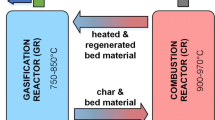Abstract
Development of liquid biofuels has entered a new phase of large scale pilot demonstration. A number of plants that are in operation or under construction face the task of addressing the engineering challenges of creating a viable plant design, scaling up and optimizing various unit operations. It is well-known that separation technologies account for 50–70% of both capital and operating cost. Additionally, reduction of environmental impact creates technological challenges that increase project cost without adding to the bottom line. Different technologies vary in terms of selection of unit operations; however, solid–liquid separations are likely to be a major contributor to the overall project cost. Despite the differences in pretreatment approaches, similar challenges arise for solid–liquid separation unit operations. A typical process for ethanol production from biomass includes several solid–liquid separation steps, depending on which particular stream is targeted for downstream processing. The nature of biomass-derived materials makes it either difficult or uneconomical to accomplish complete separation in a single step. Therefore, setting realistic efficiency targets for solid–liquid separations is an important task that influences overall process recovery and economics. Experimental data will be presented showing typical characteristics for pretreated cane bagasse at various stages of processing into cellulosic ethanol. Results of generic material balance calculations will be presented to illustrate the influence of separation target efficiencies on overall process recoveries and characteristics of waste streams.







Similar content being viewed by others
References
Laser, M., Schulman, D., Allen, S. G., Lichwa, J., Antal, M. J., & Lynd, L. R. (2002). Bioresource Technology, 81, 33–44.
Schultz, T. P., Blermann, C. J., & McGinnis, G. D. (1983). Ind Eng Chem Prod RD, 22, 344–348.
Playne, M. J. (1984). Biotechnology and Bioengineering, 26, 426–433.
Holtzapple, M., Lundeen, J., Sturgis, R., Lewis, J., & Dale, B. (1992). Applied Biochemistry and Biotechnology, 34–35, 5–21.
Chundawat, S. P. S., Venkatesh, B., & Dale, B. E. (2007). Biotechnology and Bioengineering, 96, 219–231.
Sendich, E., Laser, M., Kim, S., Alizadeh, H., Laureano-Perez, L., Dale, B., et al. (2008). Bioresource Technology, 99, 8429–8435.
Chang, V. S., Burr, B., & Holtzapple, M. (2007). Applied Biochemistry and Biotechnology, 63–65, 3–19.
Torget, R., Himmel, M., Wright, J., & Grohmann, K. (1988). Applied Biochemistry and Biotechnology, 17, 89–104.
Aden, A., Ruth, M., Ibsen, K., Jechura, J., Neeves, K., Sheehan, J., et al. (2002), Lignoscellulosic Biomass to Ethanol Process Design and Economics Utilizing Co-Current Dilute Acid Prehydrolysis and Enzymatic Hydrolysis for Corn Stover., National Renewable Energy Labaratory, Golden, CO, NREL/TP-510-32438.
Cuzens, J. C., & Miller, J. R. (1997). Renewable Energy, 10, 285–290.
Kochergin, V., Kearney, M., Herbst, R. S., Mann, N. R., Garn, T. G., & Hess, J. R. (2004). Challenges for membrane filtration of biomass derived solutions. Houston: AIChE Annual Meeting.
Monavari, S., Galbe, M., & Zacchi, G. (2009). Biotechnology for Biofuels, 2, 6.
De Queiroz, G. A., & Stradi, B. (2007). Dilute Ammonia Process for the Treatment of Lignocellulosic Materials, PCT/033173/US2009
Kochergin, V., Olmstead, S., & Jacob, W. (2001). Zuckerindustrie, 126, 376–379.
Sluiter, A., Hames, B., Scarlata, C., Sluiter, J., & Templeton, D. (2005). Determination of structural carbohydrates and lignin in biomass: NREL laboratory analytical procedure. Golden: NREL.
Saska, M., & Gray, M. (2006). Pre-treatment of sugarcane leaves and bagasse pith with lime-impregnation and steam explosion for enzymatic conversion to fermentable sugars. 28th Symposium on Biotechnology for Fuels and Chemicals, Nashville, TN
Prior, B. A., & Day, D. F. (2008). Applied Biochemistry and Biotechnology, 146, 151–164.
De Queiroz, G. A., Stradi, B., Vazan, V., & Ramachandran, T. (2009). Ethanol Production from Sugarcane Bagasse by an Ammonia Process. Bioresource Technology. In Review.
Glasser, W. G., & Wright, R. S. (1998). Biomass and Bioenergy, 14, 219–235.
Acknowledgments
This research was supported by DOE award (DE-FG36-08GO88151). This support does not constitute an endorsement by DOE of the views expressed in this article.
We would like to thank our colleagues from Audubon Sugar Institute, Dr. Don Day and Dr. Giovanna DeQueiroz, for their useful technical discussions and Iryna Tishechkina for helping in the experimental work.
Author information
Authors and Affiliations
Corresponding author
Rights and permissions
About this article
Cite this article
Kochergin, V., Miller, K. Evaluation of Target Efficiencies for Solid–Liquid Separation Steps in Biofuels Production. Appl Biochem Biotechnol 163, 90–101 (2011). https://doi.org/10.1007/s12010-010-9019-8
Received:
Accepted:
Published:
Issue Date:
DOI: https://doi.org/10.1007/s12010-010-9019-8




